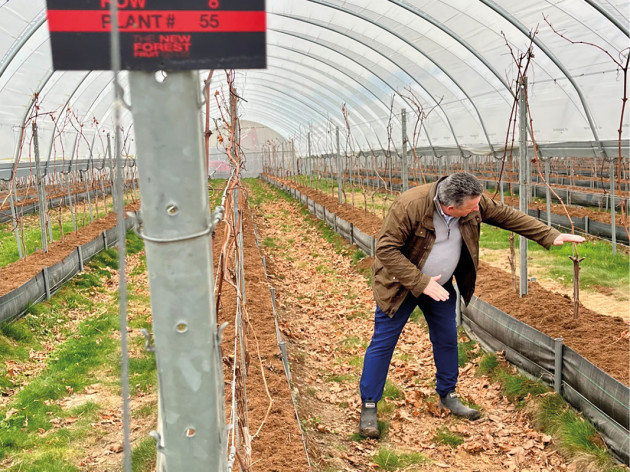
Guy Woodward: How polytunnels could enhance producers’ toolkit
From Margaret River to Mendoza, Barolo to Burgundy, I’ve seen some picturesque vineyards in my time. The B58 Winery in Beaulieu was not one of them. Muddy, grey and damp, the scene that February morning would do nothing to dispel an outsider’s preconceptions of English wine.
My host wasn’t actually an English winemaker, but a Scottish fruit farmer. And his plantings didn’t really even constitute a vineyard. At least not in the strictest sense of the term. All in all, it’s fair to say that, on arrival at B58 (named not after the road it’s on, but the year in which vines were first planted on the Beaulieu Estate), I wasn’t exactly feeling it.
February rain in Hampshire – or anywhere in the UK, for that matter – is nothing new, of course. What, after all, is the biggest pressure on English growers? Wet weather, disease and grapes failing to ripen in damp, cool conditions (witness 2024). So B58 founder Sandy Booth decided to take such hazards out of the equation by growing his vines as he does his strawberries and asparagus – under cover in polytunnels. Not only that, but he planted them in raised beds of nutrient-rich coconut coir, an environment in which the vines generate a bumper crop in just two years, averaging a whopping 4kg per vine.
Perhaps most significantly, the extra 7ºC inside the polytunnels allows him to play with previously unimagined varieties. And so it was that I tasted my first, surprisingly serviceable English Shiraz – from 2024, of all vintages – its richness aided by a short appassimento-style drying of the grapes. A 2024 Tempranillo/Grenache rosé also showed promise. Booth has already bottled a 2023 Gewürztraminer that showed good typicity, and a blend of Cabernet Franc, Merlot, Shiraz and Cabernet Jura that, if not especially complex, was certainly ripe.
B58 produced 7 tonnes of grapes last year and hopes to treble that this year. The immediate reaction, of course, is to scoff – as most people did when I told them of the enterprise. High yields? Coconut husk?? English Shiraz??? And sure, the wines are, by Booth’s own admission, very much works in progress. They’re also relatively expensive. But there is enough potential in them for the industry to take the approach seriously. Other wineries in Cornwall and Devon have already experimented with polytunnels. I suspect more will follow.
I also suspect the resistance to such methods is ideological as much as practical. A snobbism, even, over unorthodox methods and the dilution of terroir. I didn’t hear any such scoffing, though, at last month’s high-profile unveiling of another pricey, terroir-negating Syrah/Shiraz – the cross-continent La Chapelle x Grange cuvée. Several of my esteemed colleagues were positively gushing in their appraisal of the wine when presented with it in somewhat more august surroundings, at a lavish Parisian dinner, alongside the 1971 Grange and 1978 La Chapelle (though I am sure this in no way influenced their judgement).
As the estimable Matthew Jukes observed, “it would be easy to pass this off as an attention-seeking stunt” (fear not, Matthew reassures us that the wine is, in fact, “a resounding success”).
Colin Hay was even more fervent. “Iconic in its iconoclasm… not a one-night stand but a perfect match newly consummated,” he wrote, as I tried to rid my mind of disturbing images of winemakers Peter Gago and Caroline Frey in flagrante.
You had to scroll a long way down such fevered reports to find the wine’s AUS$3,500 price tag. And certainly there was no mention of the environmental cost of shipping the French component halfway across the world in a temperature-controlled, custom-made container for blending in Australia – thereby making it legal for sale in the EU – before shipping the finished article back again.
It’s easy to scoff. Ultimately, though, anything that disrupts the staid, stuck-in-its-ways wine world, and generates interest and debate, can only be a good thing. Especially, as Aussie critic Nick Ryan said, when it comes to the “bizarrely ignored” yet “consistently outstanding” Australian wine scene. “There is great benefit in Penfolds striding the world stage in this way, refusing to yield to those who think ambition is somehow a fault,” wrote Ryan.
As with the polytunnels, my guess is we’ll see more cross-country projects in the future (hell, even the normally conservative Wine Society is doing it). Ultimately, the pros of both projects far outweigh the cons. And in the current climate – economic, cultural and meteorological – the wine world needs as much innovation and imagination as it can get.




